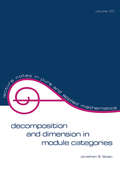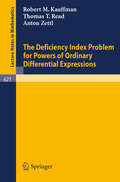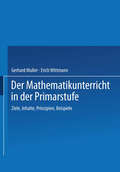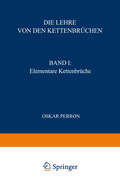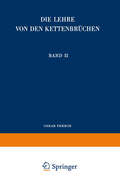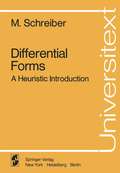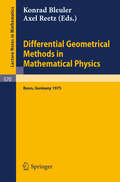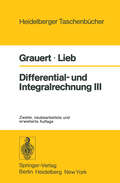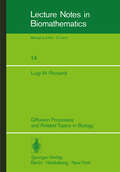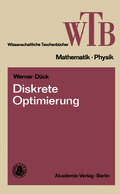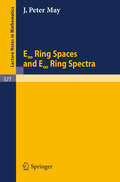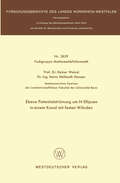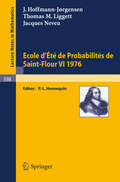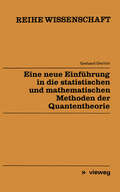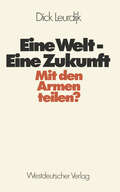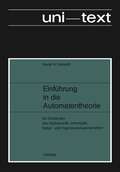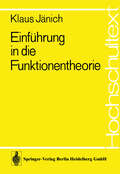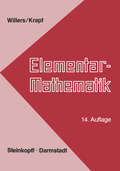- Table View
- List View
Decomposition and Dimension in Module Categories
by Jonathan S. GolanThis book examines the notions of dimension and decomposition for module categories. It discusses some basic properties of quasidecomposition functions and the complete lattice of all quasidecomposition functions taking values in a fixed given lattice.
The Deficiency Index Problem for Powers of Ordinary Differential Expressions (Lecture Notes in Mathematics #621)
by Robert M. Kauffman Thomas T. Read Anton ZettlDer Mathematikunterricht in der Primarstufe: Ziele · Inhalte, Prinzipien · Beispiele
by Gerhard Müller Erich Ch. WittmannNach einer stürmischen Bewegung in den sechzigerund Anfang der siebziger Jahre befindet sich der Mathematikunterricht in der Grundschule seit etwa zwei Jahren zweifellos in einer Phase der Konsolidierung, mit der eine kritische Revision der bisherigen didaktischen Ent wicklungen und eine Trennung von Spreu und Weizen einhergehen. Es mag mancher.1 Kollegen im gegenwärtigen Zeitpunkt als zu früh erscheinen, wenn wir mit dem vorliegenden Buch eine "Didaktik" des Mathematikunterrichts in der Grund schule vorlegen. Auch wir selbst sind uns sehr bewußt, daß unsere Konzeption nicht in dem Umfang erprobt und überarbeitet ist, wie man es wünschen möchte und wie es z. B. bei den traditionellen Rechendidaktiken in der Regel der Fall war. Wir haben uns aber trotzdem aus drei Gründen zu einer Publikation entschlossen. Erstens halten wir es für notwendig, daß die Lehrerschaft am Prozeß der weiteren Konsoli dierung mitarbeiten kann, und glauben, daß dazu Orientierungsrahmen angeboten werden müssen, innerhalb deren experimentiert und diskutiert werden kann. Das vorliegende Buch entwickelt einen solchen Rahmen.
Die Lehre von den Kettenbrüchen: Band I: Elementare Kettenbrüche
by Oskar Perroneigenen Begriffssystemen bereichert worden, die man nicht gerade als jedermann geläufig voraussetzen darf. Die Versuchung lag nahe, durch Heranziehung solcher Theorien den Kettenbrüchen einen gelehrteren Anstrich zu geben. Aber dadurch wäre nicht nur die Lektüre unnötig erschwert, sondern das Wesen der Dinge zumeist verschleiert worden, und es bestände die Gefahr, daß mancher Leser den künstlichen Anstrich für das Wesentliche halten und die harmlose Unschuld, die sich darunter verbirgt, vielleicht gar nicht mehr sehen würde. Deshalb habe ich auf logistische Hieroglyphen, geheimnisvolle "Räume" usw. verzichtet und bin bei der klassischen Wortsprache und den klassischen Rechenmethoden ge blieben. Lediglich zweireihige Matrizes wurden gelegentlich verwandt, nämlich da, wo sie einen wirklichen methodischen Vorteil bieten. Der Matrixkalkül ist ja heute in viel weiteren Kreisen bekannt als vor 40 Jahren und gehört fast schon zu den Elementen; ich habe ihn trotzdem nicht vorausgesetzt, sondern in § 5 das Wenige, was davon gebraucht wird, kurz zusammengestellt. In neuerer Zeit haben die Kettenbrüche auch in der augewandten Mathematik, z. B. in der Elektrotechnik und bei analytischen Approximationsmethoden, Verwendung ge funden. Auch den Vertretern dieser Disziplinen, sowie manchen interessierten Laien, die es trotz unseres materialistischen Zeitalters doch immer noch gibt, glaube ich durch leichte Verständlichkeit besser zu dienen als durch Paradieren mit einer übertriebenen Gelehrsamkeit. Auf die Beigabe einer möglichst lückenlosen Bibliographie habe ich ebenso wie früher verzichtet; man findet eine solche, die von den Anfängen bis ins erste Jahrzehnt unseres Jahrhunderts reicht, bei Wölffing 1.
Die Lehre von den Kettenbrüchen: Band II: Analytisch-funktionentheoretische Kettenbrüche
by Oskar PerronNunmehr kann ich auch den zweiten Teil meiner Lehre von den Kettenbrüchen, der den analytischen Kettenbrüchen gewidmet ist, als Band 11 in neuer Be arbeitung den Fachgenossen vorlegen. Ebenso wie bei dem im Jahr 1954 er schienenen Band I ging mein Bemühen dah~, den heutigen Stand der Wissen schaft in möglichst leicht verständlicher Weise darzustellen. Die leichte Ver ständlichkeit kann natürlich nicht bedeuten, daß der Leser das Buch wie einen Roman durcheilen kann. Wenn er aber die Technik der Differential-und Integral rechnung beherrscht, wenn er schon etwas von der Gammafunktion und von linearen Differentialgleichungen gehört hat und ein klein wenig Funktionen theorie weiß, kann er unschwer folgen; nur darf er, um in Einzelheiten ein zudringen, nicht die Mühe scheuen, gelegentlich Papier und Bleistift zur Hand zu nehmen und einfache Rechnungen nach gegebener Anweisung selbst durch zuführen. Es geht alles nach geläufigen Methoden. Der allgemeine Rahmen des Buches ist der alte geblieben; doch sind die sechs Kapitel mit weitgehend verändertem Inhalt gefüllt. Namentlich die ersten drei und auch die zweite Hälfte des vierten sind mannigfach umgestaltet und er weitert, während in den letzten zwei nur geringere Änderungen nötig und sogar Kürzungen möglich waren, um Raum für den neuen Stoff der früheren zu ge winnen. Überall in der Welt, besonders in der Neuen, ist in den letzten Dezennien ein reiches Material von neuen Kettenbruchtypen und neuen Erkenntnissen, vor allem in bezug auf Konvergenz, gewonnen worden, das gesichtet, geordnet und systematisch eingearbeitet werden mußte.
Differential Forms: A Heuristic Introduction (Universitext)
by M. SchreiberA working knowledge of differential forms so strongly illuminates the calculus and its developments that it ought not be too long delayed in the curriculum. On the other hand, the systematic treatment of differential forms requires an apparatus of topology and algebra which is heavy for beginning undergraduates. Several texts on advanced calculus using differential forms have appeared in recent years. We may cite as representative of the variety of approaches the books of Fleming [2], (1) Nickerson-Spencer-Steenrod [3], and Spivak [6]. . Despite their accommodation to the innocence of their readers, these texts cannot lighten the burden of apparatus exactly because they offer a more or less full measure of the truth at some level of generality in a formally precise exposition. There. is consequently a gap between texts of this type and the traditional advanced calculus. Recently, on the occasion of offering a beginning course of advanced calculus, we undertook the expe- ment of attempting to present the technique of differential forms with minimal apparatus and very few prerequisites. These notes are the result of that experiment. Our exposition is intended to be heuristic and concrete. Roughly speaking, we take a differential form to be a multi-dimensional integrand, such a thing being subject to rules making change-of-variable calculations automatic. The domains of integration (manifolds) are explicitly given "surfaces" in Euclidean space. The differentiation of forms (exterior (1) Numbers in brackets refer to the Bibliography at the end.
Differential Geometrical Methods in Mathematical Physics: Proceedings of the Symposium Held at the University at the University of Bonn, July 1 - 4, 1975 (Lecture Notes in Mathematics #570)
by K. Bleuler A. ReetzDifferential- und Integralrechnung III: Integrationstheorie Kurven- und Flächenintegrale Vektoranalysis (Heidelberger Taschenbücher #43)
by H. Grauert I. LiebDiffusion Processes and Related Topics in Biology (Lecture Notes in Biomathematics #14)
by Luigi M. RicciardiThese notes are based on a one-quarter course given at the Department of Biophysics and Theoretical Biology of the University of Chicago in 1916. The course was directed to graduate students in the Division of Biological Sciences with interests in population biology and neurobiology. Only a slight acquaintance with probability and differential equations is required of the reader. Exercises are interwoven with the text to encourage the reader to play a more active role and thus facilitate his digestion of the material. One aim of these notes is to provide a heuristic approach, using as little mathematics as possible, to certain aspects of the theory of stochastic processes that are being increasingly employed in some of the population biol ogy and neurobiology literature. While the subject may be classical, the nov elty here lies in the approach and point of view, particularly in the applica tions such as the approach to the neuronal firing problem and its related dif fusion approximations. It is a pleasure to thank Professors Richard C. Lewontin and Arnold J.F. Siegert for their interest and support, and Mrs. Angell Pasley for her excellent and careful typing. I . PRELIMINARIES 1. Terminology and Examples Consider an experiment specified by: a) the experiment's outcomes, ~, forming the space S; b) certain subsets of S (called events) and by the probabilities of these events.
E "Infinite" Ring Spaces and E "Infinite" Ring Spectra (Lecture Notes in Mathematics #577)
by J.P. MayEbene Potentialströmung um N Ellipsen in einem Kanal mit festen Wänden (Forschungsberichte des Landes Nordrhein-Westfalen #2639)
by Rainer WeizelEcole d'Ete de Probabilites de Saint-Flour VI, 1976 (Lecture Notes in Mathematics #598)
by J. Hoffmann-Jörgensen T. M. Liggett J. NeveuEine neue Einführung in die statistischen und mathematischen Methoden der Quantentheorie (Reihe Wissenschaft)
by Gerhard GerlichEinführung in die Automatentheorie: Für Studenten der Mathematik, Informatik, Natur- und Ingenieurwissenschaften
by Horst H. HomuthEinführung in die Gruppentheorie: für Studenten der Mathematik, der Naturwissenschaften und der Ingenieurwissenschaften
by Walter LedermannEinführung in die Methoden der Numerischen Mathematik: für Mathematiker, Informatiker und Interessenten der naturwissenschaftlichen Fächer
by Wolfgang BöhmDieses Buch wendet sich an Studenten der Mathematik bis zum Vordiplom, an Informatiker und an Interessenten aus anderen naturwissenschaftlichen Fächern. Vorausgesetzt werden nur Grundkenntnisse der Analysis und der linearen Algebra. Das Buch entstand aus einer einsemestrigen, dreistündigen Vorlesung, die der erst genannte Verfasser wiederholt an der TU Braunschweig hielt. Es bringt eine elemen tare Einführung in die Methoden der numerischen Mathematik. Hauptanliegen ist es, die Grundideen der algorithmischen Lösung verschiedenster mathematischer Aufgaben möglichst klar werden zu lassen, um den Studenten in die Lage zu ver setzen, verwandte Fragestellungen selbständig zu bearbeiten sowie die erlernten Prinzipien auf neue Probleme anzuwenden. Um bei den Studenten die Freude an der Praxis zu wecken, sollte der Stoff mög lichst lebendig dargestellt werden, ohne die Grundgedanken der Verfahren mit bezeichnungs-und beweistechnischen Schwierigkeiten zu überdecken. Um praxisnah zu sein, sind die Algorithmen stets in einer Algol 60 ähnlichen Schreibweise angegeben, die unmittelbar programmierbar ist. An einfachen Bei spielen wird der Ablauf der Verfahren demonstriert. Besonderen Dank verdient Frl. Dr. Ingrid Brückner, die die erste Vorlesungsmit schrift anfertigte und am Entstehen des Buches wesentlich beteiligt war. Für ihre Mithilfe beim Lesen der Korrekturen danken wir Frl. Dr. Brückner, Herrn Prof. Dr. Homuth und Herrn cand. math. Jürgen Rüger. Wolfenbüttel und Stuttgart Wolfgang Böhm und Günther Gose im Frühjahr 1977 IV Inhaltsverzeichnis Vorwort . . . . . . . . . . . . . . . . . . . . . . . . . . . . . . . . . . . . .. . . III . . . . . . . . . . . I. Grundbegriffe 1. Algorithmen und Fehlerfortpflanzung . . . . . . . . . . . . . . . . . . . .. . . 1 . . . . 1.1. Algorithmen. . . . . . . . . . . . . . . . . . . . . . . . . . . . . . . .. . . . 1 . . . . . . . . 1.2. Realisierung von Algorithmen .................................. 2 1.3. Die Beurteilung von Algorithmen ................................ 2 1.4. Aufgaben und Ergänzungen. . . . . . . . . . . . . . . . . . . . . . . . . . .. . . 3 . . . . . .
Elementary Algebraic Geometry (Graduate Texts in Mathematics #44)
by K. KendigThis book was written to make learning introductory algebraic geometry as easy as possible. It is designed for the general first- and second-year graduate student, as well as for the nonspecialist; the only prerequisites are a one-year course in algebra and a little complex analysis. There are many examples and pictures in the book. One's sense of intuition is largely built up from exposure to concrete examples, and intuition in algebraic geometry is no exception. I have also tried to avoid too much generalization. If one under stands the core of an idea in a concrete setting, later generalizations become much more meaningful. There are exercises at the end of most sections so that the reader can test his understanding of the material. Some are routine, others are more challenging. Occasionally, easily established results used in the text have been made into exercises. And from time to time, proofs of topics not covered in the text are sketched and the reader is asked to fill in the details. Chapter I is of an introductory nature. Some of the geometry of a few specific algebraic curves is worked out, using a tactical approach that might naturally be tried by one not familiar with the general methods intro duced later in the book. Further examples in this chapter suggest other basic properties of curves. In Chapter II, we look at curves more rigorously and carefully.
Elements of Optimization: With Applications in Economics and Business (Heidelberg Science Library)
by Delia KooThis book attempts to present the concepts which underlie the various optimization procedures which are commonly used. It is written primarily for those scientists such as economists, operations researchers, and en gineers whose main tools of analysis involve optimization techniques and who possess a (not very sharp) knowledge of one or one-and-a-half year's calculus through partial differentiation and Taylor's theorem and some acquaintance with elementary vector and matrix terminology. Such a scientist is frequently confronted with expressions such as Lagrange multi pliers, first-and second-order conditions, linear programming and activity analysis, duality, the Kuhn-Tucker conditions, and, more recently, dy namic programming and optimal control. He or she uses or needs to use these optimization techniques, and would like to feel more comfortable with them through better understanding of their underlying mathematical concepts, but has no immediate use for a formal theorem-proof treatment which quickly abstracts to a general case of n variables and uses a style and terminology that are discouraging to people who are not mathematics majors. The emphasis of this book is on clarity and plausibility. Through examples which are worked out step by step in detail, I hope to illustrate some tools which will be useful to scientists when they apply optimization techniques to their problems. Most of the chapters may be read independently of each other-with the exception of Chapter 6, which depends on Chapter 5. For instance, the reader will find little or no difficulty in reading Chapter 8 without having read the previous chapters.
Elliptic Partial Differential Equations of Second Order (Grundlehren der mathematischen Wissenschaften #224)
by D. Gilbarg N. S. TrudingerThis volume is intended as an essentially self contained exposition of portions of the theory of second order quasilinear elliptic partial differential equations, with emphasis on the Dirichlet problem in bounded domains. It grew out of lecture notes for graduate courses by the authors at Stanford University, the final material extending well beyond the scope of these courses. By including preparatory chapters on topics such as potential theory and functional analysis, we have attempted to make the work accessible to a broad spectrum of readers. Above all, we hope the readers of this book will gain an appreciation of the multitude of ingenious barehanded techniques that have been developed in the study of elliptic equations and have become part of the repertoire of analysis. Many individuals have assisted us during the evolution of this work over the past several years. In particular, we are grateful for the valuable discussions with L. M. Simon and his contributions in Sections 15.4 to 15.8; for the helpful comments and corrections of J. M. Cross, A. S. Geue, J. Nash, P. Trudinger and B. Turkington; for the contributions of G. Williams in Section 10.5 and of A. S. Geue in Section 10.6; and for the impeccably typed manuscript which resulted from the dedicated efforts oflsolde Field at Stanford and Anna Zalucki at Canberra. The research of the authors connected with this volume was supported in part by the National Science Foundation.
Encounter with Mathematics
by Lars GardingTrying to make mathematics understandable to the general public is a very difficult task. The writer has to take into account that his reader has very little patience with unfamiliar concepts and intricate logic and this means that large parts of mathematics are out of bounds. When planning this book, I set myself an easier goal. I wrote it for those who already know some mathematics, in particular those who study the subject the first year after high school. Its purpose is to provide a historical, scientific, and cultural frame for the parts of mathematics that meet the beginning student. Nine chapters ranging from number theory to applications are devoted to this program. Each one starts with a historical introduction, continues with a tight but complete account of some basic facts and proceeds to look at the present state of affairs including, if possible, some recent piece of research. Most of them end with one or two passages from historical mathematical papers, translated into English and edited so as to be understandable. Sometimes the reader is referred back to earlier parts of the text, but the various chapters are to a large extent independent of each other. A reader who gets stuck in the middle of a chapter can still read large parts of the others. It should be said, however, that the book is not meant to be read straight through.
